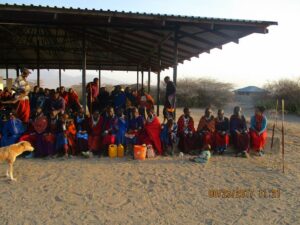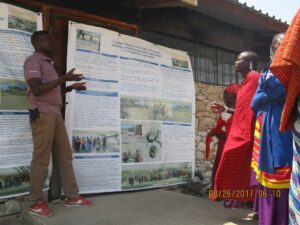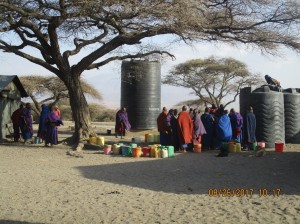Engaged Anthropology Grant: Asmeret Mehari

While a doctoral student at the University of Florida Asmeret Mehari received a Dissertation Fieldwork Grant in 2009 to aid research on “Decolonizing the Pedagogy of Archaeology in East Africa,” supervised by Dr. Peter R. Schmidt. In 2016 Dr. Mehari received an Engaged Anthropology Grant to aid engaged activities on “Toward Neighborhood Dialogue: Archaeology, Paleoanthropology, Oldupai Museum, and Community Development in Oldupai (Olduvai) Gorge, Tanzania”.
I envisioned this engaged anthropology project in collaboration with Dr. Kokeli Ryano from the University of Dodoma to focus on encouraging neighborhood dialogue among researchers, museum professionals, and local communities in Tanzania. We conducted the project in Dar es Salaam and Oldupai Gorge to fulfill three objectives: 1) collaborating with local professionals, 2) engaging the Maasai community of Oldupai Gorge in northern Tanzania, and 3) communicating research results to the University of Dar es Salaam (UDSM) Department of Archaeology and Heritage, and to the Antiquities Division of the Ministry of Natural Resources and Tourism. We fulfilled all objectives; however, this project mostly took place in Oldupai Gorge, home to the Maasai and a place of pilgrimage for numerous international tourists and researchers interested in human origins and development. Thus I share here our experience from Oldupai Gorge.
In 2010-2012, using historical and ethnographic inquiries, one of the four themes I examined in my dissertation fieldwork was: the role of African scholars in decolonizing and transforming archaeological practices and its pedagogies in Tanzania and Uganda, particularly in improving relationships with local people who reside in areas of interest for archaeological research and field school projects. The research result suggests the need to continuously problematizing and localizing archaeology, critiquing and transforming national heritage institutions, redesigning archaeology curricula, and holding dialogues with local communities[1].
We used Oldupai as a case study since it has been an area of archaeo-paleoanthropological interest for almost a century; thus, the most researched and visited archaeo-paleoanthropological site in Tanzania. Of course, its status as part of a UNESCO World Heritage Site, the Ngorongoro Conservation Area (NCA), and its 50-year old on-site museum – the Oldupai Museum, all validate our choice. Despite such reputations, the relationship between the Maasai community and researchers (archaeologists and paleoanthropologists) as well as the Maasai residents and the Oldupai Museum remained uninvestigated. Furthermore, Oldupai Gorge has neither access to formal education nor medical facilities. Maasai residents have two additional challenges: malaria and, during dry season, shortage of water.

In 2011-2012, we witnessed these challenges. Using their native language, Maa, we interviewed members of the Maasai community to understand their perceptions, reactions, and expectations of archaeo-paleoanthropological practices and practitioners. The main understanding of the community is that researchers obtain something precious, take it to their countries far away, sell it, and gain wealth. The research outcome shows continuity of colonial legacies that exclude the Maasai from sharing scientific knowledge and from fully involving them in research projects and the museum. Despite these alienations, Maasai community supports archaeo-paleoanthropological research projects and the museum. The community has strong desire to know the apparent mystery of archaeo-paleoanthropological practices and related disciplines as well as their roles in local socio-economic and educational empowerment. Maasai residents particularly emphasize the role of researchers (including us) in assisting them in obtaining access to education and finding solutions to lack of medical services, malarial problems, and water shortage. They also demand equal rights to scientific knowledge, employment opportunities and payment, full participation in archaeo-paleoanthropological activities, access to higher education in these disciplines, and direct involvement in the Oldupai Museum. As the host community, they expect global archaeo-paleoanthropological research communities, academic institutions, funding organizations, and the government of Tanzania to incorporate their rights and their needs.
In 2011-2012, we promised to partially fulfill the community’s request by presenting and publishing. We presented at three international conferences and published the research findings in an edited volume[2]. We also promised to come back and share our findings at Oldupai Gorge. Thus, we designed this engaged anthropology project and returned to Oldupai in August 2017 mostly to fulfill that promise.
We stayed with the Maasai community in Oldupai for fourteen days and in Arusha for three days to accomplish the second objective. This objective had several sub-objectives (share printed photos with the community, meet museum staff, produce informational posters, bring water for and have dialogue with the community). Mama Leken, our host, advised us to go to the river since most people spend their days at the gorge searching for water. At the Oldupai River we met people we knew and some we never met before. They were digging holes to get unsafe and unreliable water from the basin of the gorge, giving water for their sheep and goats, or washing their clothes. There we introduced the purpose of our visit and the objectives of our project. We managed to distribute most the photos taken in 2011-2012 at the gorge, at the museum, during the market day, and by visiting some families at their homes. Sharing photos helped us to reconnect with the community quickly, to recall the time we shared, and to not feel strangers.

The second sub-objective was to reconnect with the Oldupai Museum staff and to attract active participants and collaborators from the museum to achieve the third sub-objective: producing informational posters for the community. The museum staff were extremely busy preparing for the opening ceremony for the new museum. Instead, we are grateful for Mr. Emmanuel Saning’o Telele (Ngorongoro Conservation Area Authority (NCAA) staff, Mr. Orgoo Mauyai Oloisolo (Oldupai Museum Conservator), and Mr. Emanuel Gabriel Tonge (the Olbalbal Ward counselor) for organizing and attending a meeting at the NCAA headquarters. In the meeting, we discussed the content of our project and the role of NCAA in achieving it. The NCAA and the Oldupai Museum gave us a blessing to proceed the project and provided access to water storage and a truck for transporting 20,000 liter water for the community.
The community also organized several meetings: two meetings with sub-village leaders, one meeting with community members and leaders, one meeting with local representatives who participated in the production of posters, and another meeting with community members, leaders and museum staff. In the two meetings with sub-village leaders, we introduced the project and discussed the content of the book chapter in Maa language. We were thankful for their time and excitement, and the leaders were grateful to know the research result and the project’s objectives. They had a different opinion on the budget we had for water funded by Wenner-Gren. They wanted something sustainable, building a room for kindergarten or clinic. We discussed this concern at the NCAA headquarters meeting; however, we were informed that the community needs to have a permit from NCAA. The sub-village leaders organized a community meeting. They introduced us and our project, and asked community members to vote for bringing water or building a room for kindergarten. The community was also aware of the challenge of obtaining construction permit on time so we opted for water and buying eight tarps for covering the currently open-air community kindergarten.
In the same meeting, the community elected Mama Leken and Mzee Zebedayo as local representatives to collaborate with us in the poster production. After several individual and group meetings with Mzee Zebedayo and Mama Leken, we read and discussed the published chapter with them in Maa. This gave the local representatives an opportunity to understand and review the research result and to know the role of Wenner-Gren, the NCAA and the Oldupai Museum in this engaged anthropology project. We also discussed what we intended to include in the posters and the budget for producing posters, for community get-together, for bringing water, and for buying tarps for the kindergarten. The community members appreciated the whole idea of sharing research results as well as having budget transparency. Considering the local transportation problem, the local representatives advised us we buy the food for the get-together as we go to Arusha to print the posters.
In Arusha we prepared and designed informational posters in three languages; English, Swahili, and Maa in collaboration with two local volunteers, Sandey and Leken Olle Moita, the Children of Mama and Baba Leken. They live in Arusha, and they wanted to participate. They especially helped us in editing the Swahili and Maa versions. Sandey also played key role in buying the food needed for the get-together and in presenting the poster to the community at Oldupai Gorge. The posters provided the community basic information about archaeology and paleoanthropology in order to properly understand disciplinary perspectives and to share the research result from 2011-2012.
The last sub-objective was to have dialogue with the Maasai community and the museum staff through poster exhibition and get-together. The community decided to open the poster exhibition at Mturi camp. It was opened by having a one-day festivity with the community and museum staff, which involved cooking and eating food together. In the meeting, we distributed the eight tarps bought for the kindergarten and two copies of the above mentioned edited volume donated by the Publisher, Routledge: one copy for the Oldupai Museum and another copy for the community. The four-day poster exhibition facilitated discussions with the community and Museum staff to obtain an up-to-date information and to serve as a foundation for future community engagement and development projects. As token of appreciation, the NCAA brought 20,000 liters of clean water and Wenner-Gren funded for 35,000 liters. In 10 days, local leaders distributed 55000 liters of water for about 80 families who reside in the area. At the end of the project, we left the posters in English and Swahili at the Oldupai Museum, and the poster in Maa with the community. We left Oldupai Gorge on August 29.
This project allowed Maasai community to engage in research feedback. It provided museum staff, antiquities staff, and university faculty a venue to express their opinions about our research approaches and results. Some practitioners heavily criticized the research result. They thought we fabricated what we wrote in our book chapter or that our informants are outright liars. What we learned from this journey is the challenges that can be encountered doing an engaged anthropology project. We will discuss these challenges in our upcoming book chapter. We are grateful for all numerous kinds of support we received from different stakeholders.
[1] 2015 Teaching and Practicing Archaeology in East African Universities. Dissertation thesis, University of Florida, Gainesville, Florida.
[2] 2016 Mehari, A. G. and Kokeli Ryano. Maasai People and Oldupai (Olduvai) Gorge: Looking for sustainable people-centered approaches and practices. In Community Archaeology and Heritage in Africa: Decolonizing Practice. Peter R. Schmidt and Innocent Pikirayi (eds.), pp. 21-45. London, Routledge.